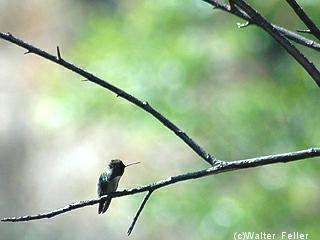Costa's Hummingbird
Calypte costaeFamily: Trochilidae Order: Apodiformes Class: Aves
DISTRIBUTION, ABUNDANCE, AND SEASONALITY
Common in summer and uncommon in winter. Most common and widespread in southern
California, but also breeds locally along the western edge of the San Joaquin Valley
(McCaskie et al. 1979) and the eastern edge of the Sierra Nevada north through Inyo Co.
Has nested in Monterey Co. since 1981, and occurs regularly in spring and summer in
Siskiyou Co. (McCaskie et al. 1988). In winter, largely restricted to the southern coast, but
also winters on southern deserts (Garrett and Dunn 1981). There is upslope movement after
breeding and during fall migration (Garrett and Dunn 1981). Occurs in more arid habitats than
other hummingbirds in California. Primary habitats are desert wash, edges of desert riparian
and valley foothill riparian, coastal scrub, desert scrub, desert succulent shrub,
lower-elevation chaparral, and palm oasis. An uncommon transient on the Channel Islands
(Garrett and Dunn 1981).
SPECIFIC HABITAT REQUIREMENTS
Feeding: Various herbaceous and woody plants provide flower nectar; also takes small
insects and spiders. In winter, exotic shrubs such as bottlebrush important (Garrett and Dunn
1981). Hovers when gathering nectar and insects.
Cover: Mostly shrubs, but also trees, provide cover.
Reproduction: Nest placed in a wide variety of trees, cacti, shrubs, woody forbs, and
sometimes vines (Bent 1940). Nest height averages about 1.5 m (5 ft) (Woods 1927). Nest
sometimes located close to water source, but more often well away from water (Johnsgard
1983).
Water: No additional data found. Nectar provides much water.
Pattern: Occurs primarily in arid scrub and chaparral habitats and in riparian edge.
SPECIES LIFE HISTORY
Activity Patterns: Yearlong, diurnal activity.
Seasonal Movements/Migration: Arrives in southern deserts in late January, but not until
mid-March on the coast and northern interior areas. Most desert breeders depart by late
May, but numbers remain high on the coast until late September. There is upslope movement
after breeding and during fall migration. Uncommon along the southern coast in winter.
Home Range: No data found.
Territory: Male has large territory, often 1 to 1.5 ha (2.5 to 3.7 ac) (Johnsgard 1983).
Territory usually contains scattered tall perches and many food sources.
Reproduction: Breeds from March through May in the deserts, and from April through July
on the coast. Promiscuous; female nests in close proximity to others in favorable areas (Bent
1940). Usually 2 eggs laid, and 1 brood raised per season. Incubation lasts 15-18 days.
Young altricial; fledge in 20-23 days. All nesting duties performed by female, as is usual in
hummingbirds.
Niche: As with other small hummingbirds, apparently taken infrequently by predators.
REFERENCES
Bent, A. C. 1940. Life histories of North American cuckoos, goatsuckers, hummingbirds,
and their allies. U.S. Natl. Mus. Bull. 176. 506pp.
DeSante, D. F., and D. G. Ainley. 1980. The avifauna of the South Farallon Islands,
California. Studies in Avian Biol. No. 4. Cooper Ornithol. Soc., Lawrence, KA. 104pp.
Ehrlich, P. R., D. S. Dobkin, and D. Wheye. 1988. The birder's handbook. Simon and
Schuster, New York. 785pp.
Johnsgard, P. A. 1983. The hummingbirds of North America. Smithsonian Inst. Press,
Washington DC. 303pp.
McCaskie, G., P. De Benedictis, R. Erickson, and J. Morlan. 1979. Birds of northern
California, an annotated field list. 2nd ed. Golden Gate Audubon Soc., Berkeley. 84pp.
McCaskie, G., P. De Benedictis, R. Erickson, and J. Morlan. 1988. Birds of northern
California, an annotated field list. 2nd ed. Golden Gate Audubon Soc., Berkeley.
Reprinted with suppl. 108pp.
Woods, R. S. 1927. The hummingbirds of California. Auk 44:297-318.
California Department of Fish and Game. California Interagency
Wildlife Task Group. 2005. California Wildlife Habitat Relationships version 8.1 personal computer program. Sacramento, California.

Costa's Hummingbird
Calypte costae
Very small, a mature adult grows to only 3 to 3½ inches in length. The Costa's Hummingbird is fairly common in the arid brushy deserts and any nearby gardens of the Southwestern United States and the Baja California Peninsula of Mexico. Like all other hummingbird species the Costa's Hummingbird feeds on flower nectar and any tiny insects that it happens to find in the flower petals.